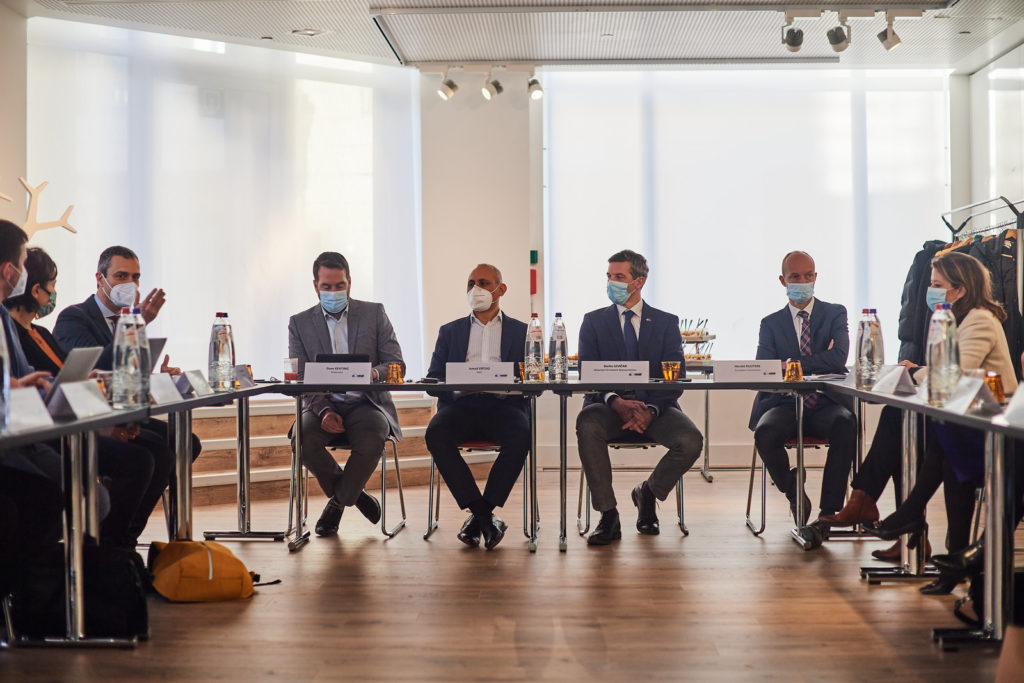Key representatives from the European Union institutions and members from the Forum for Mobility and Society met this morning in Brussels to discuss the Alternative Fuels Infrastructure Regulation (AFIR). The debate was carried out under the Chatham House rule to encourage active and honest discussions on the proposals under AFIR.
This meeting was the Forum’s first in-person event after almost two years of virtual meetings. The meeting respected the Belgian COVID-19 regulations on events, such as mandatory mask-wearing throughout the event and checking of the Covid safe ticket upon entry.
The Forum’s co-chair, member of the European Parliament and rapporteur on the AFIR proposal, Ismail Ertug (S&D), was present during the debate and discussed AFIR in more detail. From the European Commission, Herald Ruijters, Director of Investment, Innovative and Sustainable Transport at DG MOVE, was present and discussed how this relates to the European Green Deal. Darko Levičar, Counsellor for Intermodal Transport at the Slovenian Council Presidency was also in attendance and contributed views from the Council’s perspective.
Members who were present during the debate included representatives from ACEM, Bridgestone, ChargePoint, FIA Region I, FIM, Goodyear, IRU and Michelin.
Topics of discussion during the debate included whether the proposal provisions were ambitious enough to meet consumer and market demands. Stakeholders agreed that the current proposals are headed towards the right direction, but some voiced out that more ambitious targets are still needed to incentivize Member States to further develop the infrastructure for electric vehicles or other alternative fuels.
A combination of different mechanisms and methodologies such as distance-based and fleet-based approaches was deemed appropriate. Stakeholders also welcomed alternatives beyond electrification, such as hydrogen and biofuels. Two-wheeled vehicles, such as electric motorcycles, scooters, and mopeds, should also be considered.
When it comes to interoperability, most of the participants agreed that a harmonized payments system should be put in place across future charging networks for electric vehicles. It should be possible for consumers to carry out ad-hoc charging and use common means of payments such as credit cards.
Certain considerations must be made for transport industry workers such as truck or bus drivers, who often travel long routes. If drivers had to use personal mobile phones in accessing charging points, or if drivers would be required to charge their vehicles during resting hours, this could have further implications in labour laws. Moreover, for regular consumers, cost is an issue that will most likely take centre-stage as prices for electricity will go up in the short- and medium-term during the transition.
Majority agreed that focusing on urban nodes can provide positive impact in terms of electric vehicles uptake due to potential consumer buy-in in urban areas. Transit corridors should also be more heavily considered during infrastructure development due to the heavy traffic involved in these routes.
Although there will be differences in approaches in urban, sub-urban and rural areas, it is important to take incremental steps to reach climate targets. A consumer can make the switch to use electric vehicles or hybrid vehicles more easily once the infrastructure is already in place. This takes the combined coordination and efforts from various stakeholders, including consumers, manufacturers, and policy makers at the EU and national levels.
About Forum for Mobility and Society
The Forum for Mobility and Society brings together mobility stakeholders from the industry and civil society. It organises regular debates on current mobility issues, actively involving European Institutions such as the European Parliament and the European Commission.
